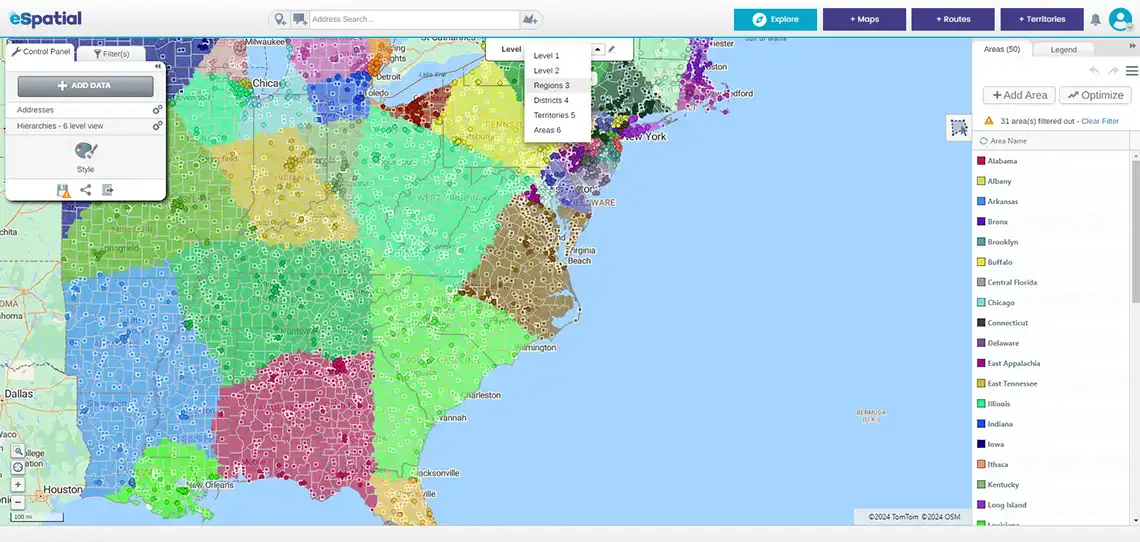Quick answer
The Bottom-up Advantage
Bottom-up planning flips the script: frontline employees drive the strategy, ensuring accuracy and ownership.
Staff on the ground know the market best. Using their data creates realistic targets and happier teams.
The benefits
- Employee-led: Teams set their own objectives
- Sharper forecasts: Real-world insights improve precision
- Agility: Businesses adapt faster to market shifts
- Territory win: The most effective method for optimising territory management
Successful businesses don't guess—they plan. This usually involves choosing between two distinct strategies: top-down or bottom-up.
Each approach impacts how your team grasps the vision and drives sales.
- The stakes: Choosing the wrong style creates friction. Choosing the right one fuels growth
- What's ahead: We compare both methods to help you decide which best supports your territory management goals
What is top-down planning?
Top-down planning: The executive view
In top-down planning, strategy starts at the C-suite and flows down.
How it works: Executives set the targets—revenue, market share, strategy—and mandate them to the team. Leaders set the goal, but frontline workers must invent the plan to hit it.
The trade-off
- The good: Speed. Decisions are streamlined and fast
- The bad: Resentment. Ignoring employee input kills morale
What is bottom-up planning?
In bottom-up planning, the decision-making process starts at the lowest level.
- How it works: Employees define the objectives and tasks. Senior leadership reviews and approves them
- Why it works: Frontline teams understand their workflow and capacity best
- The result: No more abstract, unattainable goals. Workers are empowered to set targets they can actually hit based on their department's specific reality
The Benefits of a Bottom-up Approach
Most businesses prefer bottom-up planning for one reason: it works.
By sourcing strategy from the ground up, you create a plan that is realistic, agile, and backed by the people who have to execute it.
The 5 key benefits
- Boost engagement: Employees own the plan because they helped build it
- Adapt faster: With buy-in already secured, teams pivot quickly to market changes
- Sharpen forecasts: Real-world data from the frontline beats assumptions from the top
- Optimize resources: Workers know exactly where waste lives—and how to cut it
- Deepen insights: Staff spot trends and pain points first, keeping you ahead of the curve
The Role of Bottom-up Planning in Territory Management
Bottom-up planning streamlines how you manage customer segments—whether by geography, industry, or needs. It keeps teams organized and workloads balanced while uncovering hidden sales opportunities.
The upside
- Smart allocation: Resources go exactly where they are needed
- Expansion: Teams proactively explore new territories to grow the customer base
- Efficiency: Removes the guesswork from distributing accounts

Easily switch between different levels of the hierarchy
With sales territory planning, companies can stay organized, allocate resources properly, and distribute workloads evenly.
Drive Growth With eSpatial
Bottom-up planning fuels better territory management . eSpatial gives you the tools to execute it. You get better insights, smarter allocation, and higher morale when you align territory maps with frontline reality.
The impact
- Identify opportunities: Spot gaps using real-world feedback
- Optimize resources: Match workload to capacity perfectly
- Tailor strategy: Customize plans for every specific territory
What's next: Ready to strengthen your bottom-up approach? Our platform creates fully customizable solutions for your business. Let's connect

